Germany’s two
luxury liners, BREMEN and EUROPA, have not only played an important part in their country’s mercantile
revival, but have added also an immortal chapter to the history of
transatlantic travel.
Copy
from Shipping Wonders of the World
From part 6,
published 17 March 1936
editing
by Earl of Cruise
ss / ts BREMEN in her early years - Source: Shipping Wonders of the World/Bundespresse Archiv
The
PRIDE OF A NATION - the NORDDEUTSCHER LLOYD quadruple-screw turbine express liner BREMEN.
The keel of this ship was laid in June 1927. Her launch took place in August,
1928. In less than a year later, the Bremen made her
first voyage to America, when she crossed the Atlantic from Cherbourg to New
York in four days seventeen hours forty-two minutes, thus setting up a new
record and gaining the coveted “Blue Riband”. During the passage the Bremen attained an average speed of 27.83 knots.
ss / ts BREMEN in her early years - Source: Wikipedia
For
the populace of the WWI winning Allies it must have been a wonder, seeing the
new German Greyhounds:
-
hadn´t they had an outraging inflation?
-
arn´t they occupied with the rebuilding of the country?
The
German Greyhounds earned disaproval as they came from Germany and did break
with traditional views, as well astonishment because of their modernity.
From
the German perspective BREMEN and EUROPA had been the answer to: Yes we are a
civilsed nation and this our contribution to a modern civilised world.
Earl
of Cruise
NORDDEUTSCHER LLOYD promotion poster for the new express liners BREMEN and EUROPA - source: Fernweh auf Schiffplakaten, Helmur Cauer
A
great liner’s departure from port rouses feelings of high hope, adventure and
romance. It is a big moment and even the most hardened traveller does not
become wholly accustomed to it. Sometimes this departure is accompanied by
ceremony and festivities. When the r.m.s. EMPRESS OF BRITAIN leaves, many-coloured streamers are
cast down to the quay below. As the ship is taken slowly out into midstream
these streamers break from her, reluctantly, it seems, as if those who are
holding them are anxious to maintain this last friendly link between ship and
port.
rms EMPRESS OF BRITAIN, in comparison to the nearly same aged BREMEN and EUROPA an antique design - courtesy by Daryl LeBlanc an artist in colouring old b/w picturs
The
departure of the two German super-ships, BREMEN
and EUROPA,
is accompanied by the playing of a band. The bigness of the moment is
emphasized by the music. The echoes of that music remain when the ship is many
miles out.
Sailing-day
is only one of the many memorable things for a passenger in either the Bremen or the Europa.
These
two ships are near sister ships being built in different yards, in Bremen the
BREMEN and Hamburg the EUROPA. and were launched on successive days in August,
1928. Their dimensions and layouts are approximately the same: thus if we
describe one ship we also describe the other. They were both holders of the
coveted BLUERIBAND of the Atlantic. The Bremen crossed from
Cherbourg to New York in 4 days 17 hours 42 minutes, beating the MAURETANIA´s
record of 5 days 3 hours 14 minutes. BREMEN’s average
speed on the westbound trip was 27.83 knots. On the return, or eastbound, trip
she created yet another record, completing the trip in 4 days 14 hours 30
minutes, at an average speed of 27.91 knots. These times have since been
bettered by the Bremen.
rms MAURETANIA in cruise livery, prior to her retirement CUNARD send the old lady on cruises - Source: Kreuzfahrtträume, Klocke Verlag
This record-breaking maiden
voyage was in July, 1929, and in the following March, the Europa
made her maiden voyage also in record time, completing the westbound trip in 4
days 17 hours 6 minutes, at 27.91 knots.
For some crossings old MAURETANIA battled with BREMEN for the BLUE RIBAND, lost, but did a brilliant job with her old machines.
Earl of Cruise
ss / ts BREMEN in herlater years with enlarged funnels, as the sodding of the vessel, the decks and passengers had been a problerm with original squad funnels - Source: Geschichten um das Blaue Band, Deutsche Post AG
With an overall length of 286.1 m
/ 938 ft 8 in, a moulded breadth of 31.07 m / 101 ft 8½ in, a draught of 10.33 m / 33.89 ft and a gross
tonnage of 51,656. BREMEN has features which were, at
the time of her construction, unique. The stem is cut away in a manner then not
at all usual with large ocean-going liners. Tank experiments, and an increased
knowledge of stream-lining, made her designers decide to give her a bulb-shaped
stem below the waterline, in place of the hitherto universally-used fine stem.
This innovation gave the ship buoyancy forward and also prevented her from
plunging in rough seas and lifting her propellers.
ss / ts BREMENpromotional postcard, running, published by NORDDEUTSCHER LLOYD - own collection
Universal admiration was accorded
to the fine performance of the BREMEN. After her first
triumphant westbound trip to New York, the ship remained there for five days,
during which time some 70,000 people visited her. On the homeward voyage the Bremen set up another record, covering the eastward crossing
at an average speed of 27.91 knots in four days fourteen hours thirty minutes.
ss / ts BREMEN on the slip, at AG WESER, dispicting the bulbous bow - own collection
Another innovation gained the Bremen a slight increase in speed. The plates on the hull
overlap forward instead of aft, so that as the water runs along the side of the
ship it meets a series of blunt edges. These experiments, which are common to
both ships, have been followed with intense interest by the shipping world, and
they have proved to be successful.
If the Bremen
and the Europa are fast ships they are also comfortable
ships, two qualities which, in the past, have not always gone together. If a
passenger wishes to get to America in fewer than five days he also wants to get
there in comfort, and the owners of the BREMEN and the EUROPA were determined from the outset that this should be
so. Comfort must not be sacrificed on the altar of speed. The future of
shipping may see faster and larger ships than the two vessels that have done so
much towards regaining German maritime power and prestige, but they must all
provide comfort. The passengers, numbering over 2,000 in either ship, have
accommodation that is unsurpassed in its luxury.
The first-class section of the BREMEN can take 732 passengers, and the cabins in which they
are accommodated have mahogany bedsteads, fitted wardrobes, bedside tables, dressing-chests
- which may also be used as writing-tables - and easy chairs. All cabins have
basins with running hot and cold water; the baths have cold fresh water as well
as hot and cold sea water.
ss / ts BREMEN I.class lounge, original colour photogrphay - own collection
The interior style of BREMEN and EUROPA was not the then ultra modern and tres chique
BAUHAUS style, but MODERNE SACHLICHKEIT which came near to BAUHAUS with its
clean lines. Some argue there has been lost something for the two express
liners not using BAUHAUS for outfitting ... perhaps both ships may have been
become known then for that innovative and provocative interior BAUHAUS style as
NORMANDIE for the ART DECO style.
The exterior
design of BREMEN and EUROPA was provoking modern, with squad funnels and a
rounded superstructure underneath the bridge house. Both express liners must
have been a shock to traditionalists, or those used to the common sight of
ships, which was dominated by the "traditional British design".
Earl of Cruise
In the suites de
luxe, no two sets are decorated alike. These suites de
luxe are situated in the middle section of B Deck, on both the port and starboard
sides of the ship. A special ante-room leads to the drawing-room and bedroom of
each suite. Adjoining the bedroom is a wash-room leading to a bath-room. If the
drawing-room is used as an extra bedroom another wash-room is provided.
The public rooms in the
first-class section are not only a triumphant combination of utility and
beauty, but also they are notable for the striking designs, carried out by some
of the leading German artists. The dining saloon extends upwards through three
of the eleven decks and can accommodate 600 people. The colour scheme is
carried out in ivory, sea-green and gold. Indirect and direct lighting give a
soft and beautiful effect to the entire saloon.
Adjoining this is the famous
Porcelain Room, which contains the special dining-rooms. The walls of this room
are covered with porcelain Dutch tiles, and the centre wall has a relief of the
late President Hindenburg, who sponsored the launch of the ship on August 16,
1928. The other special dining-room is on the port side, and is known as the
Hunt Room, the walls of which are decorated with charming Gobelin tapestries.
The passenger accommodation in the other classes is equally up-to-date and most
comfortable.
ss / ts BREMEN Sundeck Restaurant, located on the top deck between the funnels, waiters in waiting - courtesy Richard Fleischhut/NDL Photograph - own collection
ss /
ts BREMEN Main Restaurant, - courtesy collection of John Cunard-Shutter - © Richard Fleischhut
Dining on board the BREMEN and
EUROPA was an experience in itself and was only rivaled by the served food on
board the liners of COMPAGNIE GÉNÉRALE TRANSATLANTIQUE, as the service for the
passengers, either in I.class or III.class. And when the dark ages in Germany
begann, and German ships got more and more boycotted, NORDDEUTSCHER LLOYD did
all and the best avoiding Nazi propaganda on board and toped the service level
to never known hights. Therefore especially the BREMEN and EUROPA had still
been seeked by international travellers on the North Atlantic. Even cruises
with the express liners, under charter of RamondWhitcomb, sold easily and
reached fully booked levels.
Earl of Cruise
All the public rooms in BREMEN call for description, but they are so numerous that
they need a chapter to themselves. In this great ship there is so much to see,
however, and we have little time in which to see it. Thus we must content
ourselves with a visit to parts that can be accepted as typical of the SPECIAL
UNSINKABLE LIFEBOATS form part of the equipment of BREMEN
and EUROPA. All the lifeboats are motor-driven. The
motor is watertight-encased and can operate even if water is in the boat. The
capacity of each boat is 145 persons and provides seating space for all. The boats
can be launched simultaneously.
From the ante-room of the main
dining-room lifts take us down to the swimming pool, which is laid out in
mosaic and marble. The pool can be used by swimmers and non-swimmers. But it is
more than a swimming bath, and many passengers use it as a health resort. An
air-pearling device on the floor of the bath distributes sea air throughout.
Large round lunettes and inserted parabola reflectors convey mighty rays of
light into the bath. These reflectors not only give a wonderful lighting
effect, but they are also of therapeutic benefit to the body.
ss /
ts BREMEN lifeboats, - courtesy Shipping Wonders of the World
Realism is obtained from
constantly-moving water. This is achieved through the water being sucked off by
means of a special pump installed at the deep end of the bath and readmitted at
the shallow end through a water cascade device.
In every way BREMEN
and EUROPA live up to the title of floating cities. There is no amenity of
civilized life that cannot be obtained in either of these super-ships. Every
form of popular recreation is provided, including gymnasiums, rifle ranges,
cinemas, bowling alley and ballrooms.
ss /
ts BREMEN funnel, cleaners at work, - courtesy Shipping Wonders of the World
CLEANERS AT WORK on the funnels
of one of the great German liners.
ss /
ts BREMEN funnel, canvas protection for the ventilators - courtesy Kunstmuseum Moritzburg/Halle - © Richard Fleischhut
The two funnels of the Bremen
are 14.93520m x 6.096000m / 49 by 20 feet in diameter. Those of sister-ship EUROPA measure 17.98320m x 6.705600m / 59 by 22 feet.
ss /
ts BREMEN Kindergarten, - courtesy collection of John Cunard-Shutter - © Richard Fleischhut
Nor are the children neglected. A
passenger can take his children in either of these ships, happy in the
knowledge that the juvenile playrooms will occupy the children’s attention
throughout the voyage. These rooms contain many attractions, including a
variety of toys, a Punch and Judy show and a Christmas-tree upon which there
are movable birds. The walls of these rooms are decorated with landscapes, wild
animals and paintings of the sea and lighthouses. Under a ceiling set with
stars, the sun and the moon are also represented, and these can be lighted by
means of a switch. The trip across the Atlantic may take only four and a half
days, yet they may be vital days in the affairs of a passenger. It may be
imperative for him to be in touch with his business. This can be arranged. In
the BREMEN is a radio exchange and stock exchange. Here
the passenger can not only be kept posted with the activities of Wall Street,
but he can also buy or sell stocks and shares, and communicate with New York in
a few minutes. The wireless, too, is at the disposal of passengers wishing to
dispatch personal telegrams. It has been stated that one can leave for a trip
on either of these two vessels at the shortest possible notice, and without
having to make any special preparations so far as clothes are concerned. This
is true, since the ships have a variety of shops. EUROPA
has no shopping promenade, but she is equally well supplied with shops. The
shopping promenade in the BREMEN is world-famous. This
is approximately 2.438400m / 8 feet wide and 14.93520m / 49 feet long. The
pear-wood-and-gold walls and enclosures of the built-in show cases are
decorated in blue and yellow, and lined with pigskin.
ss / ts BREMEN indoor swimming pool, Art Deco is showing its signs - © Richard Fleischhut
THE SWIMMING POOL in the Europa is 10.97280m / 36 feet long and 5.943600m / 19½ feet
wide and lined with blue-green glazed tiles. The bath can be filled to a height
of 1.676400m / 5½ feet or 0.9144000m / 3 feet. Fresh air is forced into the
water under pressure, and to keep it at a uniform temperature, the water can be
whirled round by a gyro-pump. At the same time it is brought to the required
temperature by a special heater. The pool is brilliantly illuminated.
ss / ts BREMEN the bridge - © Richard Fleischhut
ss / ts BREMEN post office - © Richard Fleischhut
Now we must take a trip behind
the scenes. We must see and admire the organization that enables these two
leviathans to be the acme of comfort, speed and safety. Let us go down into the
engine-rooms, to the very heart of the ship, where men watch pressure gauges
and delicate instruments ceaselessly, day and night, so that the schedules
shall be maintained. The technical details of these two ships are substantially
the same, and if we describe those of the EUROPA they
will also serve for those of the BREMEN.
ss / ts BREMEN meeting ss / ts EUROPA at sea - © Richard Fleischhut
The EUROPA
is equipped with a steam turbine plant consisting of four large geared turbine
aggregates. Each set is composed of a high-pressure turbine, a medium-pressure
turbine and a low-pressure turbine. Two of the turbine sets are in a forward
engine-room, and two in the aft engine-room. The total output of the “ahead”
turbines for an ocean speed of 26 knots amounts to about 84,000 shaft hp,
which, to attain a speed of, say, 27 knots, must be increased to 105,000 shaft
hp.
promotion of NORDDEUTSCHER LLOYD for ss / ts BREMEN and ss / ts EUROPA - own collection
Entering the boiler rooms on
BREMEN and EUROPA was only via air lock possible, as both ships had in these rooms
a low pressure to highten the boiler pressure level.
The boiler and the
machine equipment were designed by Professor Dr. Gustav Bauer. BREMEN had four airtight boiler
rooms. The combustion air for the oil burners of the boilers was blown into the
boiler rooms by eight steam turbine blowers. The resulting positive
pressure meant that the boiler rooms were only accessible through airlocks. The
steam was generated in 20 oil-fired water tube boilers, eleven double-enders
and nine single-enders in four banks fired by a total of 227 oil burners. The
operating pressure was 23 atm = 24 bar
with a steam temperature at the superheater discharge of 370 °C. The maximum
steam generating capacity was 500 tons/h. For harbour operation three boilers
with their own blower were available, so that during work periods the main
boiler airlocks could remain open. The total heating surface amounted to 17,050
m ², the superheater surface 3,875 m ² and the air preheater surface 8,786 m ².
The feed water was preheated to 130 °C and the fuel oil consumption was 33
tons/h or 380 g/HP/h or 800 tons/Day, fed from oil bunkers with a capacity of
7,552 tons.
ss / ts EUROPA at night - courtesy Russ Willoughby Collection
BREMEN had four geared steam
turbines that could generate approximately 135,000 sHP. Each of them had a high
pressure, a medium pressure, low pressure and a reverse turbine. In reverse,
65% of the forward power was available. At cruise speed the turbines made 1800
rpm while the propellers made 180 rpm for a power output of 84,000 sHP. The
four propellers were bronze and had a diameter of 5,000 mm, pitch of 5,200 mm
and weighed 17 tons each. The 230 V electric power on the ship came from four diesel
generators with a total output of 520 kW. On board, there were total of 420
electric motors, approximately 21,000 lamps, electric cookers and 20 elevators.
A crew of 170 men and 30
engineers did work in the machine rooms in each BREMEN and EUROPA.
Source: Wikipedia, editing by Earl of Cruise
ss / ts BREMEN and ss / ts EUROPA in a pasinting by Stephen Card - courtesy Stephen Card
The boiler plant is also divided
into two separate and independent main groups. It consists of twenty water-tube
boilers with a total heating area of 180,800 sq ft. Each boiler generates steam
by burning oil fuel. As soon as the steam passes through the turbines, four
condensers and other complementary gear re-convert it to water, used to feed
the boilers. Each set of turbines has an independent condenser with
approximately 10,250 cooling tubes. Cooling water taken from the sea totals
about 32,000 tons an hour.
At the wheel:The helmsman in the
wheel-house of the Bremen. Electricity and wireless
play a leading role in the guiding of this great liner, which has a gross
tonnage of 51,656 an overall length of 938 ft 8-in, a moulded breadth of 101 ft
8½-in and a load draught of 33 ft 10½-in. All orders from the bridge are
electrically transmitted. For communicating with various points in the ship
forty-six telephones and a network of speaking tubes have been installed.
ss / ts BREMEN leaving in her early years Columbus Kaje in Bremerhaven, greeted by spectators - © Columbus Cruise Center
If the engines are of no direct
concern to the passengers, other machinery is. The total passenger
accommodation in the Bremen is 2,147, and in the Europa
2,164. These passengers have to be fed at least four times a day. Thus it is of
vital importance that the stores and perishable foods should be fresh
throughout the voyage, A special refrigerating plant has been fitted for this
purpose. The cooling capacity of this plant is some 400,000 calories an hour.
From this plant brine conduits are laid to the numerous refrigerators, the fresh
water coolers and also to the air coolers.
Electric lights, electric current
for the operation of the twenty-three electric lifts and the 10,000 bells in EUROPA
are also the concern of the passenger. The electric current for lighting and
power is guaranteed by four large Diesel dynamos installed in a special
auxiliary engine-room. This Diesel plant enables 420 motors and auxiliary
engines to be set working. It also supplies current to more than 20,000 bulbs;
the Bremen’s plant supplies over 30,000 bulbs.
ss / ts BREMEN 1,200 light bulbs gleaming her name into the dark, a feature later copied by NORMANDIE - own collection
When either BREMEN or EUROPA
passes another ship at night she lights up her name, the letters of which are
prominently displayed on the starboard and port sides of the sun-deck
restaurant. No fewer than 1,200 bulbs are required to illuminate these letters.
There have been many “unsinkable”
ships. The history of the sea is besmirched with the tragic untruth of this
description. But it can be said of BREMEN and EUROPA that two safer ships have
never been launched. The pumps and auxiliary plants in these vessels are driven
partly by steam and partly by electricity. A vast reserve power is on hand so
that the working of the ship cannot be handicapped or endangered.
EUROPA by night: This ship made her
first outward voyage to New York in March, 1930. The vessel maintained an
almost continuous speed of 28 knots and crossed the Atlantic in four days
seventeen hours six minutes, thus beating the record of her sister ship Bremen by thirty-six minutes. The Europa
has a gross tonnage of 49,746, an overall length of 282,77 m / 936 ft 9¼-in and
a moulded breadth of 31.00070m / 101 ft 8½-in. Her total passenger capacity is
2,195. Her load draught is 10.24890m / 33
ft 7½-in.
all pictures below have been coloured by Daryl LeBlanc
ss / ts BREMEN leaving in her later years Columbus Kaje in Bremerhaven - © Columbus Cruise Center
ss / ts BREMEN aproaching New York in the late 30s - own collection
ss / ts BREMEN embarking at Columbus Kaje - own collection
ss / ts BREMEN aereal photgraphy - own collection
ss / ts BREMEN embarking in her early years at Columbus Kaje in Bremerhaven - own collection
ss / ts EUROPA leaving her Builder BLOHM&VOSS in Hamburg 1930 - own collection, © BLOHM&VOSS
All six photographies above, have been coloure by Daryl LeBlanc.
All six photographies above, have been coloure by Daryl LeBlanc.
Both ships have a double bottom
that runs the length of the vessels from bow to stern and is sub-divided into
fifteen watertight compartments by fourteen watertight bulkheads. The reserve
of buoyancy has been so arranged that in the event of two adjacent watertight
compartments being filled with water it is impossible for either ship to sink.
But there is an even greater proof of safety. In the aft of these ships three
adjacent compartments, and in the fore part as many as four adjacent
compartments, could be filled with water and the ships would not only float,
but could also proceed on their voyage.
The lifeboat apparatus in these
ships is unsurpassed. BREMEN and EUROPA have large unsinkable lifeboats, which
are motor-driven. The motor is encased, and if any boat should be filled with
water the motor can still function. The boats each hold 145 people, and all
passengers and crew can be comfortably seated. In the event of a sudden alarm
the boats can be lowered simultaneously.
ss / ts BREMEN a view through the davits to see - © Richard Fleischhut
ss / ts BREMEN in dock, policemen "investigating" the power providers - © Richard Fleischhut
The horror of shipwreck has no
place on a voyage in either of these large liners, nor does the fire terror -
which is perhaps even worse than that of shipwreck - exist. There is an
extensive fire-extinguishing plant, a number of hand apparatus and
fire-extinguishing pumps - which can eject about 45,900 cubic feet an hour.
Fire alarms, operated by pressing
a button, are distributed throughout the ships. In front of the two funnels in
either ship, two electric fog-bells have been erected. All orders from the
bridge are transmitted by electricity.
Even this is not the limit to the
number of safety devices. These include the long and short-wave radio transmitters,
the wireless telephone, a gyro-compass with automatic steerer, the radio
direction finder and the submarine acoustic plant. For finding the depth of the
sea a modern echo depth-finder is used.
We cannot conclude our brief tour
of these two ships without a reference to the catapult aeroplane in the Bremen. This device enables the mails to reach Bremerhaven or
New York many hours earlier than if they had been transhipped in the usual way.
Three days have been saved on the delivery of mails between New York and
Berlin.
The catapult plant itself is
erected on a wheel-rim and rotates on a pin so that it can be swung round to
either side of the ship. Planes up to a total weight of 3½ tons can be started
from the catapult. The aircraft used in BREMEN can maintain an average speed of
118 mph and can carry approximately 440 lb of mail.
Ships of beauty, record-breakers,
leaders of their country’s maritime revival, BREMEN and EUROPA have added a
new, yet significant, chapter to the history of transatlantic travel. Further
these two liners fueled the new competition which was leading to the
superliners of the flirty thirties - NORMANDIE, NIEUW AMSTERDAM, CONTE DI
SAVOIA, REX, QUEEN MARY, QUEEN ELIZABETH.
Earl of Cruise
ss / ts BREMEN impressions - courtesy Kunstmuseum Moritzburg/Halle - © Richard Fleischhut
ss / ts BREMEN was definitely not an ART DECO liner, but all the way ART DECO was hinting and lurking around, one of the Staircases on board
AN ELECTRICAL GUIDE in BREMEN, to
enable passengers to find their way about the decks of the vast ship. The
passenger presses the appropriate button, and his route is illuminated on the
panel.
A mail-carrying seaplane being
catapulted from the sun-deck of BREMEN. With the aid of this seaplane a record
time of five days eleven hours for mails between New York and Berlin was set up
on the first eastbound voyage. This represented a saving of three days on
previous times.
ss / ts BREMEN impressions - courtesy Kunstmuseum Moritzburg/Halle - © Richard Fleischhut
Marlene Dietrich amidst her luggage on her way to Hollywood and "divinity"
Relaxing passengers on Deck chairs
Ventilators on top deck near the funnels
Bill Miller stated in LINERS OF
DESTINY, that only QUENN MARY sold off and was profitable, non other liner was.
NORMANDIE was 100% paid by the French gouvernment and can be seen as a state
labour program, but the running costs of NORMANDIE could be covered by the sold
tickets, especially from those of I.class as these high priced tickets covered
the running costs, and the I.class of NORMANDIE had an average occupation rate
of 85% during service. BREMEN and EUROPA did despite not sell off their
builduing costs, as of the Stock Exchange crash of 1929, but the running costs
had been covered more than only good. A different case was with the Italian REX
and CONTE DI SAVOIA, equally private financed as BREMEN and EUROPA, even if the
original lines had to merge per decre of the Duce, they hardly covered the
running costs, despite their more attractive routing from America to Europe -
they marketed as the Lido Liners, as of their vast open deck spaces that
created a beach atmosphere on board. NIEUW AMSTERDAM, pre paid by the
Netherlands, came to late but paid off in the 50s and 60s.
ss / ts BREMEN impressions - courtesy Kunstmuseum Moritzburg/Halle - © Richard Fleischhut
ss / ts BREMEN passengers gather to see New York after a crossing in festivity - © Richard Fleischhut
CUNARD really was on the winning
side with QUEEN MARY as the building costs had been heavily subsidised by the
gouvernment, as of national pride (the French could build a better ship than we
have?). But even in the 30s QUEEN MARY was hardly paying off her costs of
building, but those of running the ship. When after WWII QUEEN MARY was joined
by QUEEN ELIZABETH, CUNARD was offering the fastest and unrivalled
Transatlantic service and got the main share of the business and made profits.
But there was still a place and money making rivalry from France with slower
vessels, but better service and food, the Dutch NIEUW AMSTERDAM and the German
liners of NORDDEUTSCHER LLOYD, the BERLIN, the EUROPA - ex KUNGSHOLM and last
but not least the BREMEN - ex PASTEUR and HAMBURG ATLANTIK LINIE´s HANSEATIC 1
- ex EMPRESS OF SCOTLAND/JAPAN. Their higher service level and food quality
made them profitable and a success amoung travellers.
Earl of Cruise
ss / ts BREMEN diagram showing the class sections, as well those for the crew - © Die Geschichte der deutschen Passagierschiffahrt, Arnold Kludas
BREMEN
|
EUROPA
USS Europa AP-177
LIBERTÉ
|
|
Flag
|
||
Typ
|
Turbine passenger vessel
|
Turbine passenger vessel
|
Homeport
|
Bremen
|
Bremen
Boston
Le Havre
|
Owner
|
NORDDEUTSCHER LLOYD, Bremen
|
NORDDEUTSCHER LLOYD, Bremen
United States Navy
Compagnie Générale
Transatlantique
|
Builder
|
DeSchiMAG-Werft
AG „Weser“,
Bremen
|
|
Cost of
construction
|
ca. 65
Millionen Reichsmark
|
ca. 65
Millionen Reichsmark
|
Keel
laying
|
18. Juni
1927
|
|
16. August
1928
|
15. August 1928
|
|
Take over
|
5. Juli
1929
|
|
Maiden Vvoyage
|
19 March 1930
|
|
286,1 m (Lüa)
|
282,77 m (Lüa)
|
|
031,1 m
|
031
m
|
|
Draugth
|
010.33
m
|
010.25
m
|
55.600 t
|
56,400 t
|
|
51.656 BRT
(1929)
|
49.746 BRT
|
|
Crew
|
966 bis
1.000
|
965
|
Machine
|
4 sets of Parsons-steamturbines
24 Boilers
4 Steamturbines |
4 sets of Parsons-steamturbines
24 Boilers
4 Steamturbines |
Power
|
max. 135.000 PS
/ 99.292 kW ()
|
max. 130.000 PS / 95.615 kW
|
Speed
|
29,0 kn
(54 km/h)
|
27.5 knots
(50.9 km/h; 31.6 mph)
|
Propellers
|
Quadruple fixed
propellers
|
Quadruple fixed
propellers
|
Decks
|
12
|
12
|
max
Passenger capacity
|
2,228 total passengers
|
2,195 total passengers
|
811 Erste Klasse
|
860 first class
|
|
500 Zweite Klasse
|
502 second class
|
|
300 Touristen-Klasse
|
305 tourist class
|
|
617 Dritte Klasse
|
617 third class
|
|
Classification
|
Germanischer Lloyd
|
|
Captured by Allied forces
|
||
Claimed as war prize by the US
Navy
|
||
Maiden Vvoyage for CGT 16 July
1950
|
||
1950 to 1963
|
||
Destroyed by fire on March 16th
1941
|
Retired in 1962 and scrapped in
1963 in La Spezia
|
A catoon dipicting the Swastika Event in New York - copy from book
As Nazism gained
power in Germany, BREMEN and her pier in New York were often the site of Anti-Nazi
demonstrations. On 26 July 1935 a group of communist demonstrators boarded BREMEN
just before she sailed and tore the Nazi flag from the jackstaff
and tossed it into the Hudson River. At the time there was a dual flag law,
by which both the black-white-red horizontal tricolour with the added
black-red-gold national flag of the German Republic (Weimar Republic), and the
swastika flag were simultaneously official national flags of Germany. As the ship's swastika flag was the one tossed into the
river, US authorities claimed that no symbol of Germany had been harmed. On 15
September 1935 Germany changed its flag law, removing the status of the
black-white-red flag of former imperial Germany with which the Nazis on coming
to power had replaced the black-red-gold flag of the Weimar Republic as co-national flag.
Black-red-gold was the symbol of
the May revolution 1848, while the black-ehite-red flad symbolised the leading
power in Germany Prussia (black and white) and the Hanseatic cities (red and
white).
ss / ts BREMEN sailing in the Panama Canal on her cruise Around South America, organized by RaymondWhitcomb - own collection
Some people argued, this cruise was organized by Hitler himself, for a secret intelligence mission ... RaymondWhitcomb chartered the BREMEN for this cruise, organized and prepared it and gained a success
BREMEN started her South America RaymondWhitcomb
cruise on 11 February 1939, and was the first ship of this size to traverse the
Panama Canal.
ss / ts BREMEN and her last crossing to Europe, escaping the raiders - copy, own collection
On 22 August 1939, she began her last voyage to New York. After
ten years of service, she had almost 190 transatlantic voyages completed. Her
last, often hindered, voyage back to Germany was a dashing back in dark across
the Atlantic on the eve of WWII.


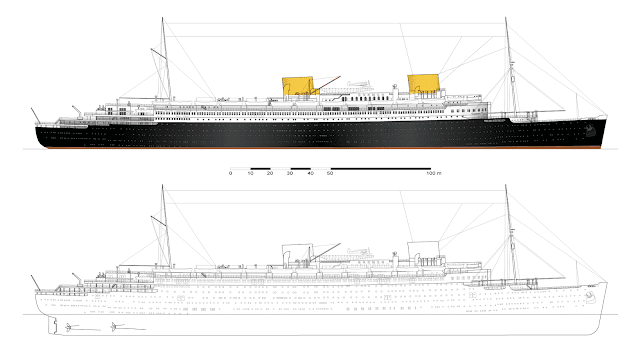






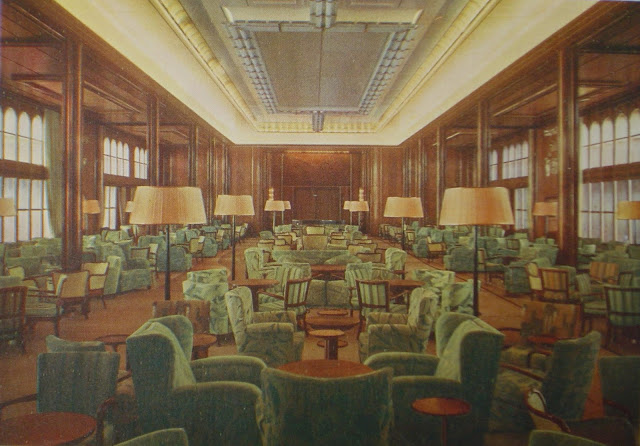
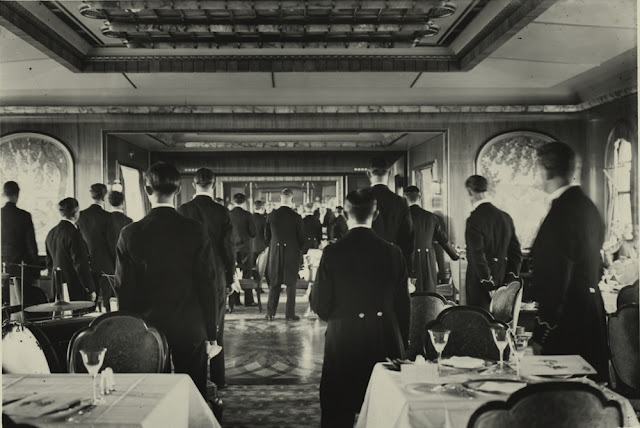

















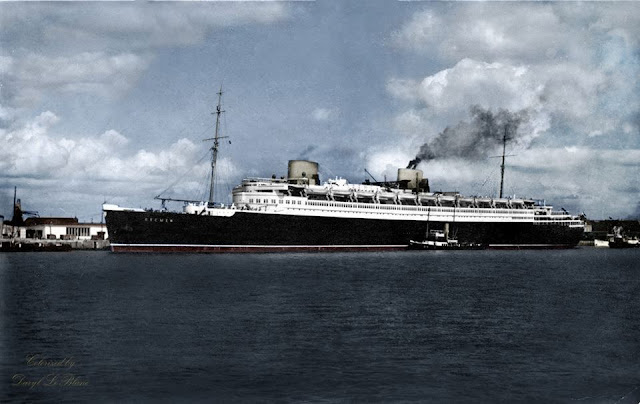








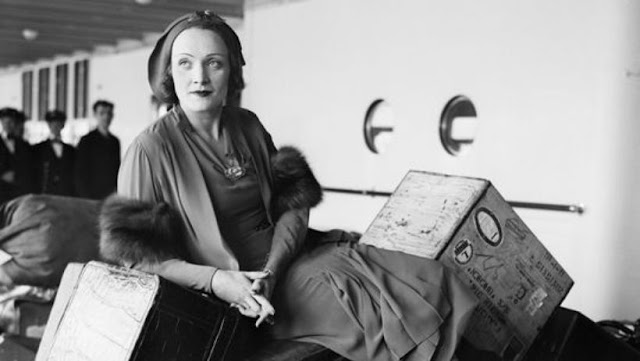
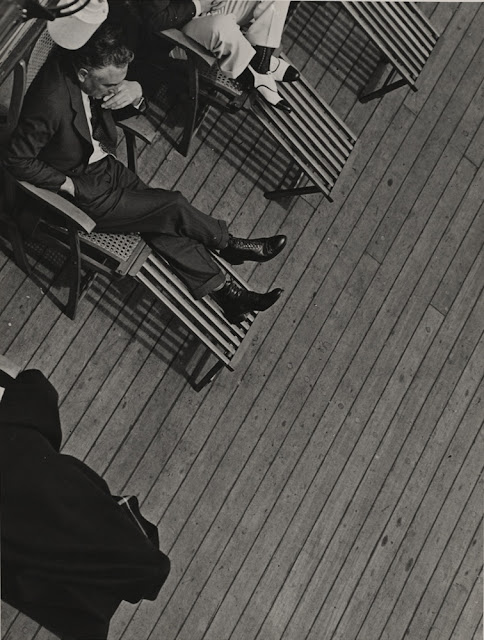






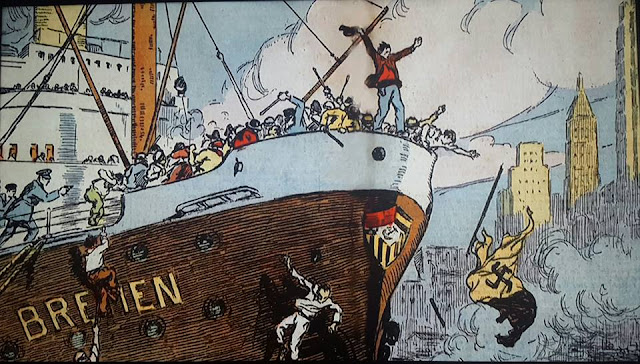


It’s really great information for becoming a better Blogger. Keep sharing, Thanks.
ReplyDeleteI am looking for the passenger and crew list for the SS Bremen for the voyage from Bremerhaven to New York arriving on July 5 or 6 , 1962. Any help that you could give me with this would be greatly appreciated.
ReplyDelete